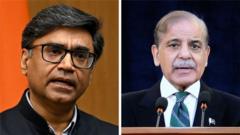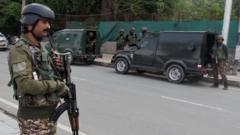Residents in Garkote face nightly fears as military tensions escalate, reminding the world that the suffering of Kashmiris often goes unnoticed.
**Kashmir's Hidden Struggles Amidst India-Pakistan Tensions**

**Kashmir's Hidden Struggles Amidst India-Pakistan Tensions**
Exploring the impact of military conflict on ordinary lives in Kashmir, as local residents endure devastating consequences.
As darkness enveloped the valley, traces of glimmering lights from both sides of the border faded—a disheartening signal for the residents of Kashmir. The call from the nearby mosque echoed through the quiet streets, a reminder to stay indoors as the threat of shelling loomed large.
I arrived in Garkote, a village nestled in the Indian-administered region of Kashmir, seeking refuge with my friend Irshad Khwaja's family. Having spent my career documenting the unrest in this strife-torn area, I knew that the situation between India and Pakistan had escalated in the days leading up to my visit.
It was a familiar sight—hills surrounded by conflict, where neighbors on opposing sides grappled with fear and uncertainty. My friend held a flicker of hope that perhaps the night would pass without incident, yet the surrounding atmosphere suggested otherwise. With military tensions surfacing into armed confrontations, Kashmiris braced themselves for a night they wouldn’t soon forget.
As the clashes intensified, so too did the anxiety of those caught in the crossfire. It is the ordinary people—those who farm the land and care for their families—who bear the brunt of these violent spectacles. Under the specter of war, the resilience of Kashmir’s residents shines through, revealing the profound human cost that accompanies political strife.
In quiet moments between the chaos, the truth of Kashmir's plight unfolds, reminding us that while political leaders rattle sabers, it is the lives of everyday citizens that hang in the balance. The world may spotlight the conflicts, but it’s the ongoing suffering of ordinary Kashmiris that truly endures.
I arrived in Garkote, a village nestled in the Indian-administered region of Kashmir, seeking refuge with my friend Irshad Khwaja's family. Having spent my career documenting the unrest in this strife-torn area, I knew that the situation between India and Pakistan had escalated in the days leading up to my visit.
It was a familiar sight—hills surrounded by conflict, where neighbors on opposing sides grappled with fear and uncertainty. My friend held a flicker of hope that perhaps the night would pass without incident, yet the surrounding atmosphere suggested otherwise. With military tensions surfacing into armed confrontations, Kashmiris braced themselves for a night they wouldn’t soon forget.
As the clashes intensified, so too did the anxiety of those caught in the crossfire. It is the ordinary people—those who farm the land and care for their families—who bear the brunt of these violent spectacles. Under the specter of war, the resilience of Kashmir’s residents shines through, revealing the profound human cost that accompanies political strife.
In quiet moments between the chaos, the truth of Kashmir's plight unfolds, reminding us that while political leaders rattle sabers, it is the lives of everyday citizens that hang in the balance. The world may spotlight the conflicts, but it’s the ongoing suffering of ordinary Kashmiris that truly endures.






















